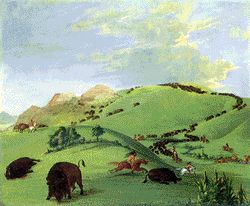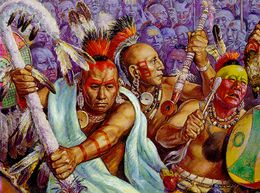|
The Osage Indians
by George Sabo III The Osage Indians lived along the Osage and Missouri rivers in what is now western Missouri when French explorers first heard of them in 1673. A seminomadic people with a lifeway based on hunting, foraging, and gardening, the seasonal movements of the Osage brought them annually into northwestern Arkansas throughout the 18th century.
Three principal hunts, each organized by a council of elders, were held during the spring, summer, and fall. The men hunted bison, deer, elk, bear, and smaller game. The women butchered the animals and dried or smoked the meat and prepared the hides. The women also gathered wild plant foods and at the summer villages tended gardens of corn, beans, squash, and pumpkins. Surplus products, including meat, hides, and oil, were traded to other Indians or to Europeans. The Osages acquired guns and horses from Europeans during the eighteenth century, which enabled them to extend their territory and control the distribution of European goods to other tribes in the region. Most men shaved their heads, leaving only a scalplock extending from the forehead to the back of the neck. The pattern of a man's scalplock indicated the clan he belonged to. Men wore deerskin loincloths, leggings, and moccasins, and bearskin or buffalo robes when it was cold. Beaded ear ornaments and armbands were worn, and warriors tattooed their chests and arms. Women kept their hair long and wore deerskin dresses, woven belts, leggings, and moccasins. Clothing was perfumed with chewed columbine seed and ceremonial garments were decorated with the furs of ermine and puma. Earrings, pendants, and bracelets were worn, and women decorated their bodies with tattoos. Osage communities were organized into two divisions called the Sky People and the Earth People. According to their traditions, Wakondah, the creative force of the universe, sent the Sky People down to the surface of the earth where they met the Earth People, whom they joined to form the Osage tribe. Each division consisted of family groups related through the males, called clans, that organized social events and performed rituals for special occasions. Each clan had its own location in the village camping circle and appointed representatives to village councils which advised the two village leaders - one representing each tribal division. Villages were laid out with houses on either side of a main road running east and west. The two village leaders lived in large houses on opposite sides of the main road near the center of the village. The Sky People clans lived on the north side of the road, and the Earth people clans lived on the south side. Council lodges for town meetings were also constructed in the larger villages.
Osage houses were rectangular and sheltered several families. Measuring up to 100 feet long, they were constructed of saplings driven into the ground and bent over and tied at the top. Horizontal saplings were interwoven among the uprights, and the framework was covered with hides, bark sheets, or woven mats, with smokeholes left open at the top. Most houses had an entrance at the eastern end. A leader's house had entrances at both ends. Village life followed rules and customs established by a group of elders known as the Little Old Men. To join the ranks of the Little Old men, serious-minded individuals had to undergo training that began during boyhood and lasted for many years. Little Old Men passed through seven stages of learning, at each stage acquiring mastery of an increasingly complex body of sacred knowledge. Ceremonies were performed for important activities and events, including hunting, war, peace, curing illnesses, marriages, and mourning the dead. Many ceremonies required elaborate preparations and participants would often wear special clothing and ornaments or paint elaborate designs on their bodies. Each clan had specific ceremonial duties that in combination served to sustain the wellbeing of the tribe. Osage lands in Arkansas and Missouri were taken by the U.S. government in 1808 and 1818, and in 1825 an Osage reservation was established in southeastern Kansas. Today there are about 10,000 Osages listed on the tribal roll, many of whom live in and around Pawhuska, Oklahoma. Bibliography Din, Gilbert C. and Abraham P. Nasitir Mathews, John J.
Sabo III, George Wilson, Terry P. |

